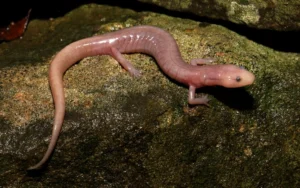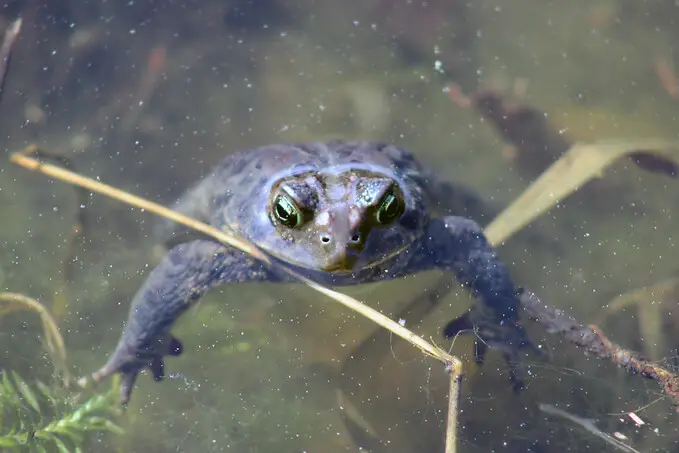Amphibians are a diverse group of species found in a wide variety of habitats, from rain forests to mountainous areas, to dry regions. But have you ever wondered if amphibians can be found in the ocean, or in other marine environments?
The majority of amphibian species can not live in saltwater because salt tends to disrupt the water and ionic exchange across their permeable skin. This can lead to serious dehydration or even death. In contrast, many reptiles such as sea snakes and saltwater crocodiles inhabit marine habitats.
That said, a few amphibian species, such as the the crab-eating frog (Fejervarya cancrivora) have adapted to survive salt habitats.
Most Amphibians Can Not Live In Saltwater
Amphibians have unique skin compared to that of many other vertebrates. Their skin is composed of thin membranous tissue that is quite permeable to water and contains a large network of blood vessels.
This permeable skin distinguishes them from mammals, birds, or reptiles.
Permeability relates to how easily a gas or liquid molecule can pass back and forth from the environment into the animal and vice versa.
Typically, the larger the molecule, the more difficult it is to enter the animal through its skin. Amphibian skin is more permeable than that of other vertebrates.
Their membranous skin allows water and respiratory gases to readily diffuse directly down their gradients between the blood vessels and the surroundings.

When in fresh water, amphibians such as frogs have a body salt content much higher than the surrounding water. For this reason, they absorb water by osmosis and lose salts by diffusion through the skin.
Their physiology compensates for this, so the concentration of their body fluids is maintained at an adequate level.
However, when amphibians are in salt water, the water around them is much more concentrated than their body fluids, especially their blood. Due to this, they would lose water rapidly and gain salts – leading to quick dehydration, or even death.
The vulnerability of amphibians to saltwater is why generally don’t find any frogs or salamanders on small oceanic islands.
This is in contrast to reptiles such as sea snakes which frequently live in seas, and inhabit oceanic islands.
Some Amphibian Species Are Known To Have Salt Tolerance
Although most amphibians are vulnerable to saltwater, an increasing number of studies have found amphibian species that are able to adapt to and tolerate saltwater habitats, especially those that live along the coast.
In 2015, American scentists Gareth R Hopkins, and Jr. Edmund D. Brodie identified 144 amphibian species from 28 amphibian families across the world, of which 124 are anurans (frogs and toads).
A few frog and toad species with a known tolerance to saltwater include the following:
- Lowland Leopard Frog (Lithobates yavapaiensis)
- Southern Leopard Frog (Rana sphenocephala)
- Crab-eating frog (Fejervarya cancrivora)
- Pacific Treefrog (Pseudacris regilla)
- Asian grass frog (Fejervarya limnocharis)
- Chinese bullfrog (Hoplobatrachus rugulosus)
- Ornate chorus frog (Microhyla fissipes)
- African Clawed Frog (Xenopus laevis)
- Mediterranean painted frog (Discoglossus pictus)
- Western Toad (Anaxyrus boreas)
- Yellow-Bellied Toad (Bombinatoridae Bombina variegata)
- Cane Toad (Rinella marinus)
- American Toad (Anaxyrus americanus)
- Fowler’s Toad (Anaxyrus fowleri)
- Southern Toad (Anaxyrus terrestris)
- Oak Toad (anaxyrus quercicus)
- European toad (Bufo bufo)
- Natterjack toad (Epidalea calamita)
- Berber Toad (Sclerophrys mauritanica)
- Balearic green toad (Bufotes balearicus)
- African green toad (Bufotes boulengeri)
- European green toad (Bufotes viridis)
These frogs and toads often live in coastal areas that get flooded by seawater, so they developed tolerance to brackish water as a survival strategy.
For example, mangrove swamps are frequently flooded daily by tidal fluctuations which results in some levels of salt water in surrounding standing water.
The Crab-eating Frog
The crab-eating frog (Fejervarya cancrivora), of south-eastern Asia is pehraps the most well-known frog to inhabit salt environments.

These frogs occur in a range of lowland habitats, but in their native environment, they are found in coastal scrub, marshes, mangroves, and coastal rice paddies.
These unique frogs can survive in fresh water, and when pushed can tolerate at least up to 80% sea water, and can adapt from one to the other in a matter of hours. However, they generally prefer a seawater concentration of not more than 40%.
Crab-eating frogs are able to survive salt water by rapidly changing levels of urea in their body tissues. Doing this prevents excessive water loss through the skin in salty conditions.
In addition, Crab-eating frogs have three glands within their skin (mucous glands, mixed glands, and vacuolated glands), which help buffer the additional salt that would otherwise enter their bodies.
Other Anurans With Tolerance To Saltwater
Apart from the crab-eating frog, another frog/toad species with amazing tolerance to seawater is the green toad (Bufo viridi) of Europe and the Middle East

Adult green toads have been found in aquatic environments with salinities as high as 2.0% in northern Europe
They have also been shown to tolerate, external salinities as high as 2.9%, for periods up to at least a month. For context, coastal seawater usually has a salinity of about 3.1%.
Many Amphibians Have Adaptations To Live In Harsh Environments
With amphibians having a wide distribution, some species live in very harsh environments. For this reason, they developed adaptations to help them live in these environments.
In addition to being able to tolerate saline habitats, green toads (Bufotes viridis), are more tolerant to arid conditions than many other amphibians.
These toads can tolerate extremely high temperatures of 40°C (104°F). They are also quite tolerant to desiccation and can withstand losing up to 50% of their body water (they only die when they lose more than 50% of their body water).
Another frog species with tolerance to arid conditions is the waxy monkey leaf frog (Phyllomedusa sauvagii) of South America.
These frogs can tolerate a wide range of body temperatures about 20 (68°F) and 40°C (104°F) – and have been shown to be able to modulate their body temperature through control of evaporative water loss.
In addition, waxy monkey leaf frogs limit water loss through the skin by lipid secretions and excretion of uric acid. During the day, they enter a state of torpor to conserve water.
Sources:
Gareth R. Hopkins and Edmund D. Brodie “Occurrence of Amphibians in Saline Habitats: A Review and Evolutionary Perspective,” Herpetological Monographs 29(1), 1-27, (1 December 2015). https://doi.org/10.165/HERPMONOGRAPHS-D-14-00006
Malcolm S. Gordon, Knut Schmidt-Nielsen, Hamilton M. Kelly; Osmotic Regulation in the Crab-Eating Frog (Rana Cancrivora). J Exp Biol 1 September 1961; 38 (3): 659–678. doi: https://doi.org/10.1242/jeb.38.3.659
Malcolm S. Gordon; Osmotic Regulation in the Green Toad (Bufo Viridis). J Exp Biol 1 June 1962; 39 (2): 261–270. doi:https://doi.org/10.1242/jeb.39.2.261

